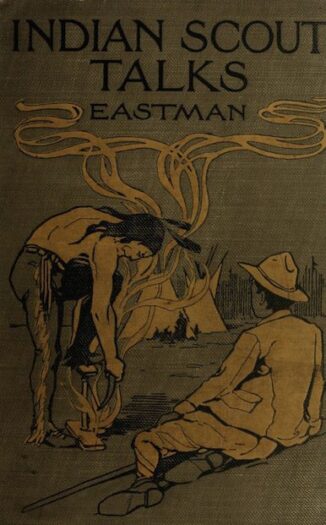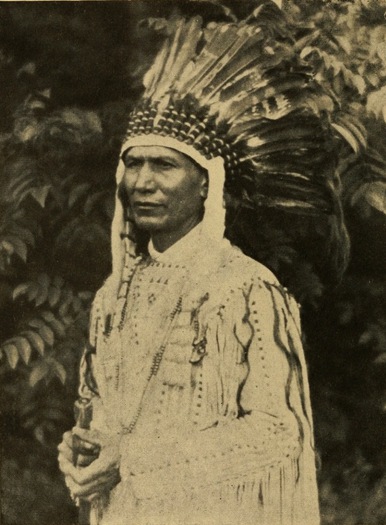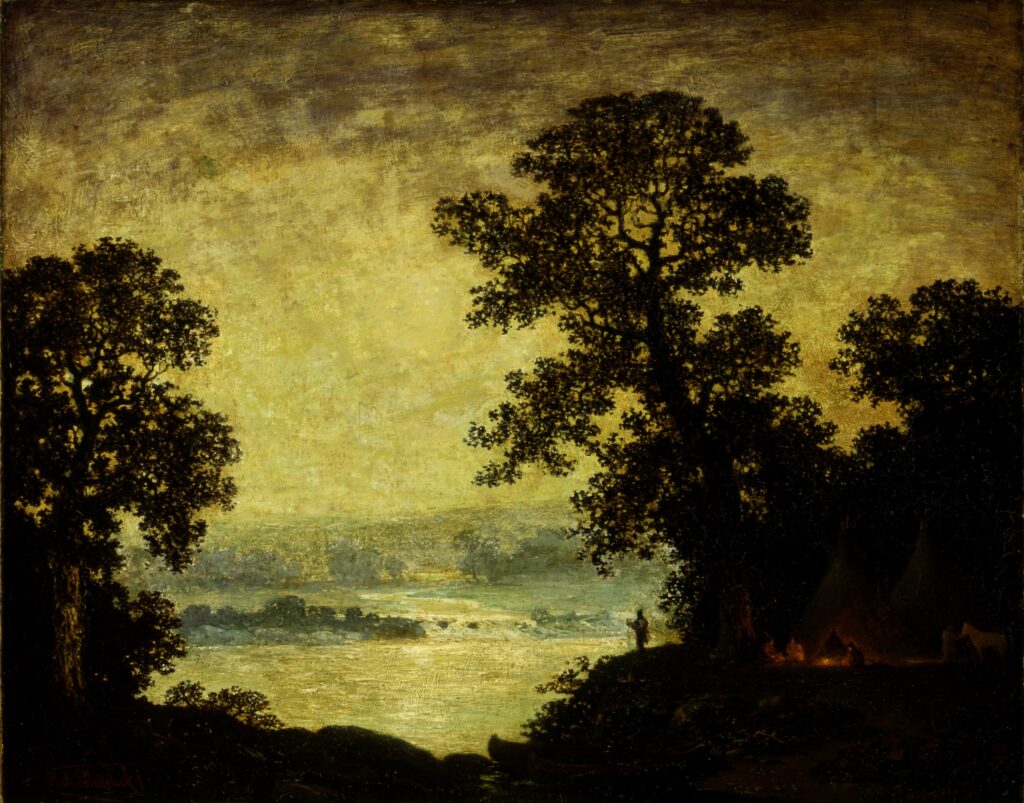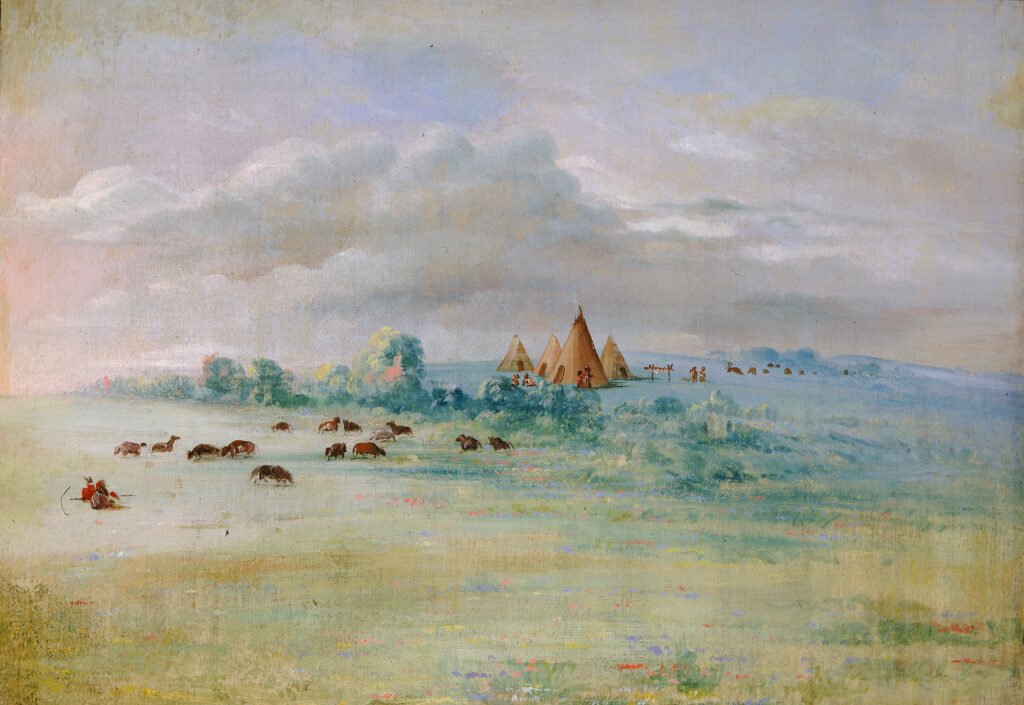At Home with Nature
By Charles A. Eastman/Ohiyesa (Santee Dakota)[1]
Annotations by Jessica Cory


Right: Portrait of the author included in the original 1914 publication. Photographer unknown.
To be in harmony with nature, one must be true in thought, free in action, and clean in body, mind, and spirit. This is the solid granite foundation of character.
Have you ever wondered why most great men were born in humble homes and passed their early youth in the open country? There a boy is accustomed to see the sun rise and set every day; there rocks and trees are personal friends, and his geography is born with him, for he carries a map of the region in his head. In civilization there are many deaf ears and blind eyes. Because the average boy in the town has been deprived of close contact and intimacy with nature, what he has learned from books he soon forgets, or is unable to apply. All learning is a dead language to him who gets it at second hand.
It is necessary that you should live with nature, my boy friend, if only that you may verify to your own satisfaction your schoolroom lessons. Further than this, you may be able to correct some error, or even to learn something that will be a real contribution to the sum of human knowledge. That is by no means impossible to a sincere observer. In the great laboratory of nature there are endless secrets yet to be discovered.
We will follow the Indian method, for the American Indian is the only man I know who accepts natural things as lessons in themselves, direct from the Great Giver of life.
Yet there exists in us, as in you, a dread of strange things and strange places; light and darkness, storm and calm, affect our minds as they do yours, until we have learned to familiarize ourselves with earth and sky in their harsher aspects. Suppose that you are absolutely alone in the great woods at night! The Indian boy is taught from babyhood not to fear such a situation, for the laws of the wilderness must necessarily be right and just, and man is almost universally respected by the animals, unless he himself is the aggressor. This is the normal attitude of trust in our surroundings, both animate and inanimate; and if our own attitude is normal, the environment at once becomes so. It is true that an innate sense of precaution makes us fear what is strange; it is equally true that simplicity and faith in the natural wins in the end.
I will tell you how I was trained, as a boy, to overcome the terror of darkness and loneliness. My uncle, who was my first teacher, was accustomed to send me out from our night camp in search of water. As we lived a roving life in pursuit of game, my errand led me often into pathless and unfamiliar woods. While yet very young, all the manhood and self-reliance in me was called forth by this test.
You can imagine how I felt as I pushed forward alone into the blackness, conscious of real danger from possible wild beasts and lurking foes. How thrilling, how tantalizing the cry of the screech-owl! Even the rustling of a leaf or the snapping of a dry twig under foot sent a chill through my body. Novice that I was, I did not at once realize that it is as easy as swimming; all I needed was confidence in myself and in the elements.

As I hurried through the forest in the direction my uncle had indicated, there seemed gradually to develop sufficient light for me to distinguish the trees along my way. The return trip was easier. When, as often happened, he sent me for a second pailful, no protest or appeal escaped my lips, thanks to my previous training in silent obedience. Instinct helped me, as he had foreseen, to follow the trail I had made, and the trees were already old acquaintances. I could hear my own breathing in the silence; my footfall and heart-beat sounded as though they were those of another person coming behind me, and while this disturbed me at first, I quickly became accustomed to it. Very soon I learned to distinguish different kinds of trees by the rustling of their leaves in the breeze which is caused by the stir of man or animal.
If you can accustom yourself to travel at night, how much more you will be able to see and appreciate in the daytime! You will become more sensible of the unseen presences all about you and understand better the communications of the wild creatures. Once you have thrown off the handicap of physical fear, there will develop a feeling of sympathetic warmth, unknown before.
In the event of sudden danger, I was taught to remain perfectly motionless—a dead pause for the body, while the mind acts quickly yet steadily, planning a means of escape. If I discover the enemy first, I may be passed undiscovered. This rule is followed by the animals as well. You will find it strictly observed by the young ones who are hidden by their mother before they are able to run with her; and they are made to close their eyes also. The shining pupil of the eye is a great give-away.
It is wonderful how quickly and easily one can adjust himself to his surroundings in wild life. How gentle is the wild man when at peace! How quick and masterful in action! Like him, we must keep nature’s laws, develop a sound, wholesome body, and maintain an alert and critical mind. Upon this basis, let us follow the trail of the Indian in his search for an earthly paradise!

Eastman, Charles A. “At Home with Nature,” in Indian Scout Talks: A Guide for boy scouts and camp fire girls, 1-6. LITTLE, BROWN, AND COMPANY, 1914.
[1] The Santee Dakota are also sometimes known as the Santee Sioux.
Contexts
The Boy Scouts, as an organization, have a lengthy history of exploiting and appropriating Native American cultures and traditions, as Vincent Schilling (Akwesasne Mohawk) explains in Indian Country Today. In becoming an icon for the Boy Scouts, Eastman received criticism of European assimilation. However, many of his supporters, such as Penelope Myrtle Kelsey (Seneca), argue that his association with the Boy Scouts was an act of resistance against the “vanishing Indian” narrative.[2] For additional information on the “vanishing Indian” narrative, please see The Pluralism Project.
Resources for Further Study
When teaching works by Native American writers, particularly older works such as those by Charles Eastman, it is critical to emphasize that Native peoples are still here. To foster this viewpoint, it can be helpful to teach contemporary Native American writers in addition to older foundational texts.
Sharing how other institutions work to counter the “vanishing Indian” trope may also provide insightful ideas.
- The Plains Art Museum, for example, is hosting an exhibition entitled The Vanishing Perspective to rebut this harmful narrative that was born of Manifest Destiny.
- This activity template is based upon a text not written by a Native person but focusing on one, which may be problematic in and of itself. Still, instructors could easily tailor the learning opportunities to discuss the “vanishing Indian” trope in other works. The template is geared for 6th-8th grade learners.
Contemporary Connections
- Cecily Hilleary explores the connection between the Boy Scouts’ appropriation of Native cultures and other popular forms of appropriation, such as sports teams’ names and logos.
- Ben Railton’s July 2020 article in the Saturday Evening Post provides a thorough overview of the “vanishing Indian” myth and its horrific effects, particularly in Oklahoma, including increased COVID-19 cases.
[2] Kelsey, Penelope Myrtle. “A ‘Real Indian’ to the Boy Scouts: Charles Eastman as a Resistance Writer.” Western American Literature, 38: no. 1 (2013): 30-48.